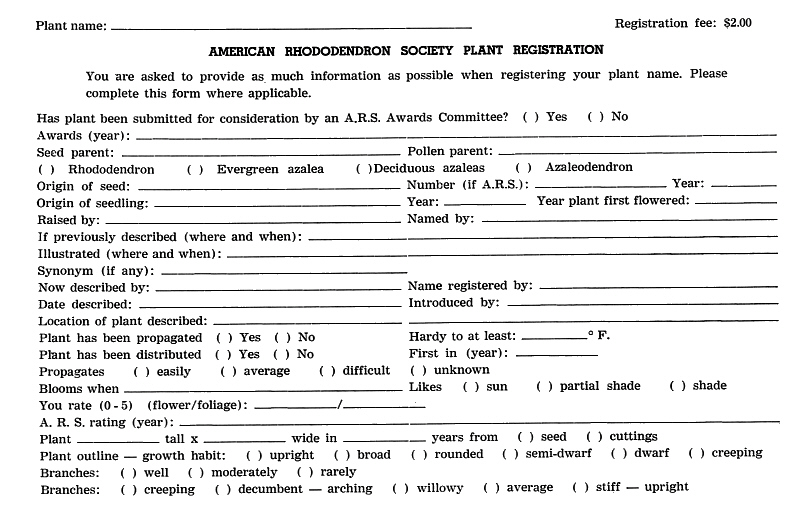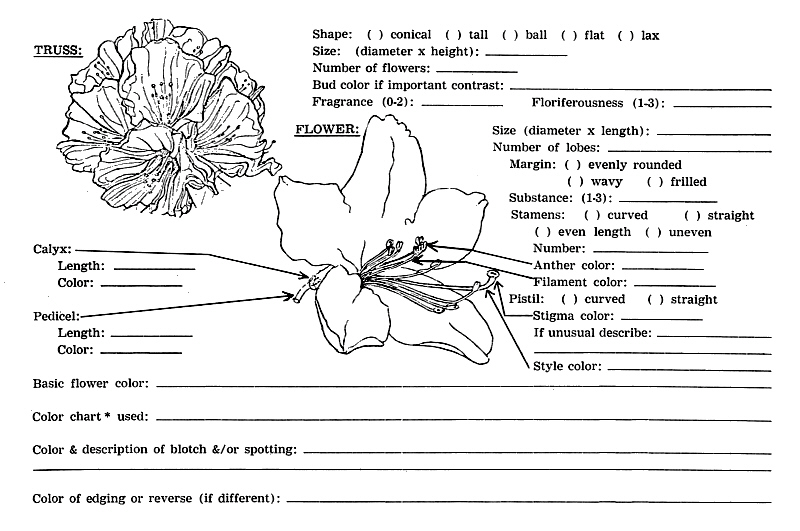Name Registration Responsibility
Edwin S. Parker. Registrar, A.R.S.
It is important that a precise, stable, and internationally accepted system should be available for the naming of rhododendron clones. Registration of these names is essential for nomenclatural stability.
Clonal names should be markedly different from botanical names in Latin form. Names formed by combining parts of the Latin names of parent species must not be used.
Names should consist of one or two words and must not be more than three words. An arbitrary sequence of letters, an abbreviation, or a numeral is counted as a word but names containing such letters, abbreviations, or numerals should be avoided.
An initial article should not be used as a part of a name. Names beginning with an abbreviation, except for "Mrs.", should not be used. The only form of address that may be used is that required by national custom, generally that for a married woman.
Names should not exaggerate the merits of the clone; nor should they be used if they are likely to become inaccurate through future introductions. Names that refer to some attribute or attributes common or likely to be common in a group of related clones should not be used. Names likely to be confused with existing names should not be used.
These relatively simple rules and recommendations for naming should not be too restrictive in choosing names for your plants. Validity of your proposed names may be simply checked by a note to the A.R.S. Registrar. You are urged to register your plant names before you distribute the plants.
The International Rhododendron Register
, 1958, is presently being updated and, when available, will list all registered rhododendron and azalea names.
The same name may not be used for both a rhododendron and an azalea but it is hoped that this rule may be abandoned in the future.
Many members have expressed concern lest we run out of names. Your Registrar does not share this fear; a little imagination and a bit of consultation with an iris, rose, or gladiolus catalog provides many fine names. At present rate of registration of 100 to 150 names a year we should not run out for some time.
To name a plant is a responsibility. Only those plants that are an improvement on what we already have should be named. Thus it is incumbent upon the namer to be familiar with the plants being grown in his area. He should remember that his plant should be a fine, unique garden shrub to be admired year-around. Once this determination has been made, a name may be selected.
Another responsibility of naming lies in the selection of a name that will "sell" the plant. Any plant worthy of a name deserves wide distribution and an easy-to-remember, euphonious name is a necessity. The namer should see to it that his plant is propagated and distributed. He should, whenever possible, submit the plant for consideration by his local A.R.S. awards committee.
A plant worth naming is worthy of a complete description and this responsibility lies with the person naming the plant. Some years from now we may wish to establish that a plant that you are growing is a particular clone. How will we know unless we have a detailed description available? The new A.R.S. registration form will provide this descriptive information. It is urged that care be taken to complete all of the requested data. Particularly important is a corolla color description from a color chart. Your local A.R.S. chapter should have one available for your use. If not, request that they procure one. The only chart presently available, except perhaps, second-hand is the R. H. S. Colour Chart From: 'The Secretary', 'The Royal Horticultural Society', 'Vincent Square', 'London SWIP 2 PE', 'England. The price is 5.25 pounds 4.20 to Fellows of the R. H. S.) plus 45 pence postage. A call to your local bank should provide the current exchange rate.
Before the current registration card was adopted, it was hoped that a descriptive card could be set up that would be amenable to data processing by the American Horticultural Society's Plant Records center. We hope in the future to accomplish this goal thus to have a readily usable catalog of rhododendrons', azaleas, 'and azaleodendrons named in the United States and Canada together with identifying descriptive data', parents, breeder, hardiness, location, 'etc. Parents that transmit certain desirable characters to their progeny could be selected practically instantaneously through computer means. We might wish to select for flower color, truss type or size, floriferousness, fragrance, flowering period, leaf retention and or plant branching, plant size, hardiness, disease resistance, or any other measurable quantity.
It is hoped that your Registrar may be of service to you. Copies of data on file concerning any registered American hybrid or species selection will be furnished upon request. Availability of any particular name usually can be quickly established.

|

|
Part of the American Rhododendron Society Plant Registration Form, as prepared by Edwin K. Parker, is reproduced here. Additional information on flower shape and size, shape and surface of leaves is requested on the form. Line drawings of leaf and flower shapes are included to assist in standardization of descriptions. Color slides or prints of truss and or plant are requested. And color charts acceptable for descriptions are listed.